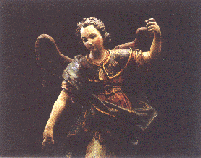 NTRODUCTION
NTRODUCTION  |
The Museo Franz Mayer is the result of both the
devotion and philanthropy fostered by the German-born
Mexican after whom the museum is named.
Franz Mayer was one of the first in Mexico to make a large scale donation with the express purpose of building a museum and has since set an example for the entire community. The objects he assembled during his lifetime, dedicated with passion to collecting art, testify to his intelligence, his exceptional sensibility and good taste; and the origin of many of them reveal his concern to recover Mexican pieces which for various pieces which for various reasons were to be found abroad. |
A glance at the pieces in is collection reveals a particular interest in the applied arts -although this never kept him from also acquiring important paintings. Consequently -and view of the absence in Mexico of such a museum- the decision was made to create "an art museum that emphasized the applied arts".
Also known as the "decorative arts" (and at one time mistakenly called the "minor arts"), "applied arts" include all those objects produced primarily with a functional purpose but that also feature a strong aesthetic component. The applied arts establish a unity between what is both useful and beautiful, and constitute one of the most representative aspects of a people's culture, reflecting both its resources and its aspirations.
 |
The Franz Mayer Museum features objects from the 16th to 18th centuries that were manufactured in various parts of the world though most are from Mexico and Spain. These pieces are displayed in galleries devoted on those objects used in a specific century; galleries dedicated to a particular art form, including silver, ceramics, sculpture and painting; and installations like the 17th-century drawing room and the 18th-century chapel, dining room and bedroom. |
The installation of the Museum saved a colonial monument from destruction. This was the former Hospital de San Juan de Dios, known at the time as Nuestra Señora de los Desamparados [Our Lady of the Forsaken], founded in 1582 by Dr. Pedro López, and known today as El Hospital de la Mujer [The Women's Hospital]. The building was jointly restored by the Government and Trust.
The museum opened its doors to the public in July 1986, and has since played a prominent role in the promotion of cultural affairs by offering temporary exhibits, lectures, book presentations and concerts.
At a time when almost everything seems ephemeral and it becomes increasingly impossible to escape the urgent demands of the immediate -at least enough so as to consider the significance of our own participation in the cultural process- a visit to the Franz Mayer Museum proves to be both a pleasant and comforting experience, confirming the existence of man's creative power and the important work of the hands in preventing the dissociation of the body and soul.
EUGENIO SISTO




©Todos los derechos reservados, se prohibe la
reproducción salvo permiso por escrito del autor.
©All rigths reserved, material duplication is prohibited
without written authorization by its author.